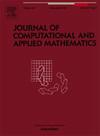一类曲面的环面密度均衡图
IF 2.1
2区 数学
Q1 MATHEMATICS, APPLIED
Journal of Computational and Applied Mathematics
Pub Date : 2025-06-17
DOI:10.1016/j.cam.2025.116844
引用次数: 0
摘要
密度均衡图是一种形状变形技术,最初是为平面地理地图的制图和社会学数据可视化而发展起来的。近年来,人们对开发表面和体积域的密度均衡映射方法以及将其应用于几何处理和成像科学中的各种问题越来越感兴趣。然而,现有的表面密度均衡映射方法仅适用于拓扑结构相对简单的表面,而不适用于具有拓扑孔的表面。在这项工作中,我们开发了一种新的算法来计算环面表面的密度均衡映射。特别是,通过在环面上规定不同的种群函数,并在具有周期边界条件的平面域上进行基于扩散的变形,可以很容易地实现不同的形状变形效果。此外,所提出的环面密度均衡映射方法为计算具有可控面积变化的第一类曲面的环面参数化提供了一种有效的方法,其中环面保面积参数化就是一个很好的例子。实验结果证明了所提方法的有效性。本文章由计算机程序翻译,如有差异,请以英文原文为准。
Toroidal density-equalizing map for genus-one surfaces
Density-equalizing map is a shape deformation technique originally developed for cartogram creation and sociological data visualization on planar geographical maps. In recent years, there has been an increasing interest in developing density-equalizing mapping methods for surface and volumetric domains and applying them to various problems in geometry processing and imaging science. However, the existing surface density-equalizing mapping methods are only applicable to surfaces with relatively simple topologies but not surfaces with topological holes. In this work, we develop a novel algorithm for computing density-equalizing maps for toroidal surfaces. In particular, different shape deformation effects can be easily achieved by prescribing different population functions on the torus and performing diffusion-based deformations on a planar domain with periodic boundary conditions. Furthermore, the proposed toroidal density-equalizing mapping method naturally leads to an effective method for computing toroidal parameterizations of genus-one surfaces with controllable area changes, with the toroidal area-preserving parameterization being a prime example. Experimental results are presented to demonstrate the effectiveness of our proposed methods.
求助全文
通过发布文献求助,成功后即可免费获取论文全文。
去求助
来源期刊
CiteScore
5.40
自引率
4.20%
发文量
437
审稿时长
3.0 months
期刊介绍:
The Journal of Computational and Applied Mathematics publishes original papers of high scientific value in all areas of computational and applied mathematics. The main interest of the Journal is in papers that describe and analyze new computational techniques for solving scientific or engineering problems. Also the improved analysis, including the effectiveness and applicability, of existing methods and algorithms is of importance. The computational efficiency (e.g. the convergence, stability, accuracy, ...) should be proved and illustrated by nontrivial numerical examples. Papers describing only variants of existing methods, without adding significant new computational properties are not of interest.
The audience consists of: applied mathematicians, numerical analysts, computational scientists and engineers.

 求助内容:
求助内容: 应助结果提醒方式:
应助结果提醒方式:


